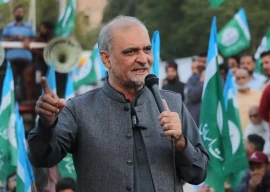A meeting between DHA and some residents, over the decision to make Khayaban-e-Mujahid one-way, began on Monday with Surah Al Kausar for the tilawat. And if you read the translation, it would seem like an ironic choice.
The case dates to December 2011 when DHA made Khayaban-e-Mujahid and Shamsheer one-way. Ninety-nine petitioners, including residents of 26th Street, went to the Sindh High Court in April 2012, arguing that DHA had done this without changing the master plan which says the two thoroughfares are supposed to be two-way streets. The SHC ruled in their favour but this was challenged in the Supreme Court. DHA won a stay order to keep the roads one-way.
In August 2013, the SC said DHA needs to get clearance from the Sindh Environmental Protection Agency (SEPA) and submit a report “after hearing all the parties concerned, which are likely to be affected”.
Thus, on Monday over a dozen residents and their lawyers met DHA’s team at SEPA. For five hours, tempers flared and subsided as the dispute unfolded in a test of nerves.
The first disagreement was on the nature of the meeting. Resident Shaheen Merchant said that the Karachi Metropolitan Corporation (KMC) was not invited even though he believed it was a stakeholder. DHA’s lawyer Haseeb Jamali argued that KMC had nothing to do with the meeting as municipal authority rested with DHA. Barrister Naim ur Rahman countered this. “I don’t know for the life of me how KMC can’t be a stakeholder,” he said, referring to its role in city-wide traffic arrangements and the “principal of natural justice”. Until the public hearing is properly conducted, he maintained, this meeting is “legally and factually flawed”.
It was problematic, the residents maintained, that Sepa had not informed the public via newspapers that it was holding this meeting. They had come because they had informally been told about it. They felt that if it had been made public, more residents would have turned up.
Also disputed was whether the meeting at the Sepa office, to which it had invited eight people, including three experts, was for a review of the initial environment evaluation (IEE) or the environmental impact assessment (EIA). These two acronyms are linked when it comes to the cost of any project. Projects under Rs50 million don’t need an EIA. The residents say DHA’s plan cost over Rs50 million and thus needed an EIA.
SEPA Chairman Naeem Mughal wanted DHA’s consultant to give a presentation but this was rejected by the residents. It was eventually agreed that they would go around the room and SEPA would note down objections from the affected parties.
An asthmatic resident, Bashir Ahmed, said that the noise and smog was so bad that he couldn’t play with his grandchildren in his lawn. His younger brother had had an accident as well. Traffic SSP (South) Tanvir Alam Odho said that no fatal accidents showed up on the record. But the residents said that the police stations did not register their cases properly and only put them as a katcha entry. Resident Humaira Khan spoke of her own accident and difficulty registering an FIR.
Resident Ms Zafar Khan said she has been taking antihistamines for allergies that had developed from the change in the environment over two years. She also pointed out that, “Our house is on an incline and with the increase in volume of traffic there are vibrations in the ground leading to structural damage.”
The residents said they can’t keep their windows open for fresh air and have been forced to rely more on air conditioning. Their privacy has been compromised by people sitting on the tops of minibuses. Resident Mrs Sartaj gave a description of how her husband now needed a hearing aid.
Asad Kizilbash of the Defence Society Residents Association said that parking plazas on Zamzama Blvd and in Khadda market were left half completed because of legal battles. Ms Zafar Khan and Kizilbash mentioned how Khayaban-e-Mujahid actually used to be a dead-end once upon a time but the Zehri house was bought and demolished and it became a thoroughfare.
Resident Hamid Siddiqui was unhappy that the EIA and IEE were not done before this decision was made. “And thus DHA is looking for ex post facto approval,” he argued.
The residents wanted to know about the DHA survey forms. The SEPA chief said even he hadn’t received them. His office had requested them from DHA 15 days ago.
Resident Shaheen Merchant asked why wider roads such as Saba Avenue, Sea View and Khayaban-e-Hafiz can’t be used? He asked why 10-lane roads were taken down to six lanes? Resident Faisal Merchant felt it was illogical that a forty-year-old master plan was being violated. “The master plan was a binding contract and we thought our lives would go according to that,” he said.
Resident Kaleem Rehman said that noise and air pollution couldn’t be measured properly if the mini buses had been temporarily rerouted by the traffic police. The SEPA chief took into account this input that when measuring the noise and air pollution he should do it over a week and not just on one day. It should be done in a way that factors in the public transport.
The last person to be heard was DHA chief engineer Brig (r) Saiyid Hasan Raza. “Maybe yes, we are incompetent,” he said, but added, “We are trying to do [our work] in the most positive way.” He stressed repeatedly that they had not made the decision “overnight” and had engaged Nespak to come up with solutions as far back as 2005.
Nespak had recommended DHA make changes in three stages with re-routing being part of the plan. Brig (r) Raza said they found in surveys that the majority of traffic on these two roads were private vehicles. Just one to two percent were freight and public transport is negligible. The peak hours were 7 pm to 9 pm. He maintained that the environment is affected by emissions and, “If you increase the traffic flow, your emissions go down, as cars are not idling.” Indeed, one resident said that the flow of traffic had improved as such. It appears, however, that it has brought with it attendant environmental degradation.
At the end of the meeting it was agreed all round that DHA should take a week to come up with some alternative solutions. There was discussion on the need for a more public hearing and that ultimately the final decision rested with the courts.
DHA’s chief engineer Brig (r) Raza and their consultant refused to share their data reports with The Express Tribune and questioned why the issue was being covered.

DHA- Residents in court
Dec 2011
DHA turns Khayaban-e-Mujahid and Shamsheer one-way
April 2012
99 residents file a petition against decision in SHC
Dec 2012
SHC rules in favour of residents, tells DHA to make road two-way
Feb 2013
DHA files appeal in Supreme Court
March 2013
SC grants DHA stay order to keep roads one-way
Aug 2013
SC orders DHA to acquire EIA in four months.
Dec 2013
SC gives DHA 15 days to get EIA
Published in The Express Tribune, January 7th, 2014.
COMMENTS (3)
Comments are moderated and generally will be posted if they are on-topic and not abusive.
For more information, please see our Comments FAQ
1732503274-0/Untitled-design-(43)1732503274-0-405x300.webp)
1732501636-0/Untitled-design-(42)1732501636-0-165x106.webp)

1732498967-0/Outer-Banks--(1)1732498967-0-165x106.webp)
1732086766-0/BeFunky-collage-(74)1732086766-0-165x106.webp)












If you buy a piece of land pay premium price for it as asked by the seller. Then the buyer has every right to demand that the same product be delivered as was committed. It does not have anything to do with status its about principle. DHA should follow its master plan on the basis of which they sold the property. If there are any traffic jams they should be handled otherwise like build a bridge, underpass etc.
All the elites should have another city for themselves to live in, I am sure they can buy or create a city in Pakistan
now its very peace living here... before this one-way traffic rule jam traffic, accidents etc.... i live on KH-Mujahid #KhaddaMkt